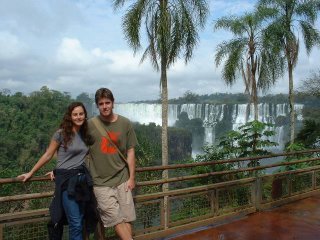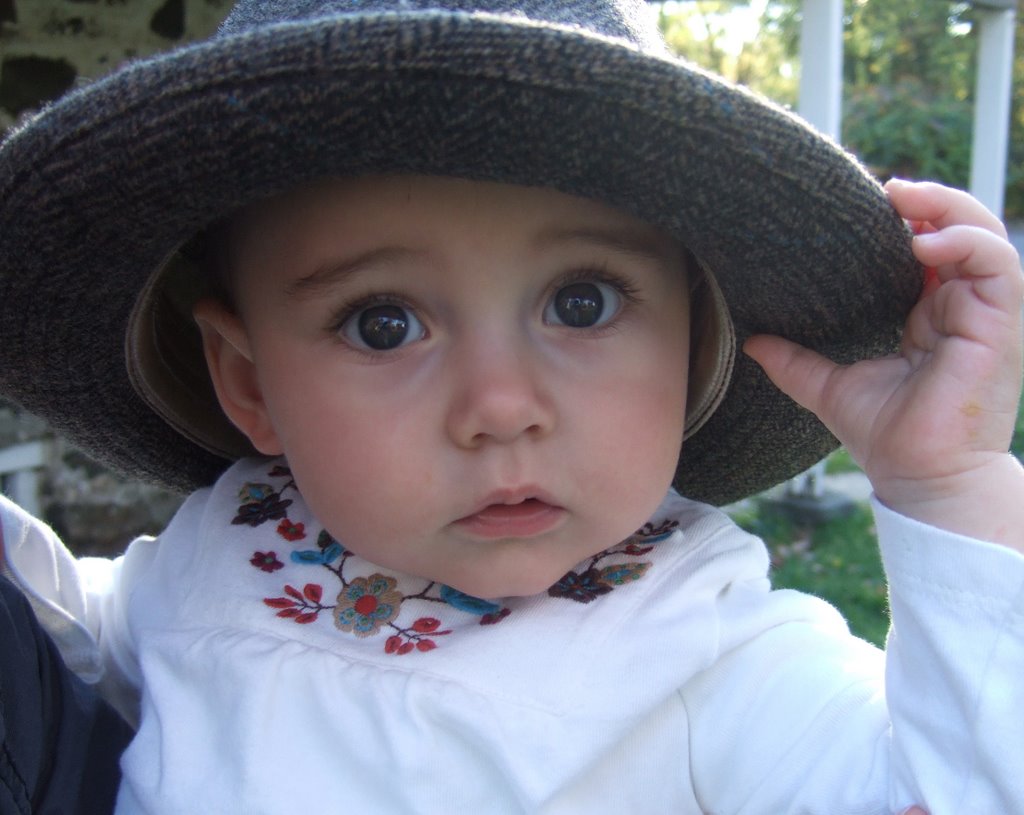Uruguay to Iguazu

Hello friends and family,
August 26, 2002
As usual, I take my time sending these updates out, and then they become mini-novels about what we have been doing, seeing, eating, hearing, tasting, listening and missing. We are now in Asunción, Paraguay, but stories of this country and photos will have to come later. Here are a few of my past journal entries...
The below was written on August 20th:
Dan and I are in Posadas (the capital of the Misiones Region of Argentina). Unfortunately, the weather has turned for the worse, and we are suffering a deluge of rain. This region is being heavily flooded, so we have spent the majority of our day cooped up in the hotel watching bad television, and listening to a 'river of water' rain on our roof. I figured that this was a good time to jot down some impressions of the past week (much better than wasting a beautiful, sunny day in an internet cafe!).
-------------------------------
Back on the road for sure... If we tallied up the hours we have spent on various buses (or in bus terminals) vs. the hours on land, I wouldn't be surprised if the wheels won out. We have covered a lot of ground, and have had to take the most circuitous routes to do so. Kudos to our friends for the new music! Too bad I have nothing better to read than a trashy Anne Rice novel. Dan however, seems to be enjoying his Moby Dick...no pun intended.
Our departure from Buenos Aires was sad, but it isn't hard to get excited about the prospect of seeing new places. Monday, August 12th, found us in a new city and a new country - Colonia del Sacramento, Uruguay. A one hour boat ride from the hustle and bustle of BA city life, and we entered the tranquilo calm of a small riverside town with tree-lined, cobble-stoned roads, and small colonial homes circling tiny park plazas. Colonia has been a popular day trip for Porteños (residents of Buenos Aires) who are looking for a breath of fresh air, and a window to a simpler, less stressed-out way of life. We spent our afternoon wandering and visiting the many free historical museums, which included old homes with antique furniture, Portuguese relics, displays of stuffed birds, dinosaur bones, and butterfly and bug collections.
The next day we were off to Montevideo, the capital of Uruguay, and its' economic, political and cultural heart line. This city is all too often compared to Buenos Aires with a negative light. This is the misfortune of Uruguay - being referred to as the poor cousin of Argentina. At first appearance, there is some truth to this statement. Montevideo has amazing turn of the century architecture, much like Buenos Aires, but the old city has only recently been recognized as an area worthy of rehabilitation, and is in need of much attention. The government has begun the slow process of renovating many of the more beautiful and historical buildings, and several of these prior 'mansions' now house museums. We spent over an hour in one historical museum with our own english-speaking guide, and I believe it greatly changed our perspective of the city and the country. Everywhere we went, people were eager to talk to us about their country, and to discuss their recent economic troubles - much like Argentina. What was most interesting about our short exploration of Uruguay was observing the cultural differences, as opposed to similarities, with Argentina. Porteños are very slick dressers in a trendy, stylish way. In comparison, we never saw so many men dressed in suits, ties, wearing hats, or sweater vests, as we did in Montevideo. These Uruguayans dressed in a classical, traditional manner. This 'old-fashioned' style was further accented by the cities architecture and the abundance of old, vintage cars. Dan was enamored of these old clunkers, even if they were in serious need of a new paint job, as our photos will show. I was surprised by the occasional horse and cart stopped at the stoplight of a busy intersection! The Uruguayan passion which stood out 100 times more intensely than it had in Argentina, was the mate drinking madness. EVERYWHERE we went, you could spot someone holding a mate cup with bombilla, and a ready thermos full of hot water. Couples, friends, young and old stop on the side of the road, or sit on their front stoops at sunset, sipping away and sharing 'tea'. There has got to be something to this mate obsession, so Dan was on the mission to find the perfect mate cup, and remaining paraphernalia. He eventually found a copper-rimmed gourd, encased in dark brown leather, and we were ready to join the Uruguayan pastime on our long bus rides.
From Montevideo, we took a day trip to Punta Del Este, considered to be 'the' South American beach resort of the rich and famous. Of course, we're in the dead of winter, so it was more of a ghost town, and not the hot, hip, models-on-the-beach, kind of destination. Despite the fact that we were probably 2 of the only 6 tourists in Punta, we were able to arrange a tour of the sites. Our guide drove us through all the wealthy neighborhoods, where we could ooh and ahh at the gorgeous, grand houses, many with thatched roofs(?). We drove over a wavelike bridge to Barra, and visited Casa Pueblo, a Gaudi-like, white coastal home and museum, built by the famous Uruguayan artist - Carlos Paéz Vilaró. This highlights another quick impression we had about Uruguay. We saw a lot of modern, abstract art/ sculptures in public spaces - parks, restaurants, hotels. For a people that seemed initially conservative, we were impressed with their forward art sense and appreciation. Overall, we found Uruguayans to be exceptionally friendly, and very tranquilo. I wish we had had more time...
------------------------------------
August 23, 2002 - Puerto Iguazu, Argentina Dan has come down with his first flu bug, or it could be food poisoning. The poor guy is in bed, sweating it out of his system, while I take this time to finish what I started...
--------------------------------------
After Punta del Este, our plan was to shoot it up to Esteros del Iberá, a wetlands wilderness in Argentina.....This entailed a trip of 5 bus rides, and thus began our longest day of travel. We bused back to Montevideo (2.45hrs), waited for 2 hours for our bus to Salto, a Uruguayan border town (traveled 6 hrs. thru the night), waited for 2.30 hrs. at the bus station, then crossed the bridge to Concordia, Argentina (an hour), then had 4.30 hours to kill before being able to catch our final 4-6 hour bus ride of the day to Mercedes. Oh the love of travel! Luckily for us, Concordia has natural Thermal springs by the Uruguayan river. With not much sleep on the night bus, we were able to relax in the hot pools for a few hours before continuing our journey. Once in Mercedes, there was no further transportation scheduled for that evening to our final destination. We were forced to give it a rest, and get a bed. Through kind recommendations, word of mouth led us to a great bed and breakfast run by an older Anglo-Argentine couple, the Pears. They spoke perfect english and were second generation Argentines, who had lived in the camp their entire adult lives, running estancias and sheep/cattle farms. Ann Marie Pear treated us to an english/argentine tea, and with her husband gave us much insight into the peculiar Argentineentine way of life. We were made to feel perfectly at home, with their dachshund, Missy, seated at our feet, and a room of antique furniture, fluffy pillows, Hola! magazines, and great big coffee table books of Argentina.
Early the next morning, we finished our long journey to Esteros del Iberá with a 3.5 hr. van trip. We arrived at Hosteria Ãandé Retá, in the small settlement of Colonia Pellegrini, hoping to stay the night. Our casual 'don't plan ahead' travel approach finally failed on us. All of the local accommodations were fully booked due to it being a long holiday weekend for Argentines. Estrella, the hosteria's director, took us under her wing, and invited us to have lunch at Nande Reta, booked us a boat tour, and even got us a room in one of her staff's houses. We took her up on everything but the boarding, and decided we'd bus it back to Mercedes that evening. Our boat launch through the marshes was amazing. The guide steered us around floating islands of grass and aquatic plants in search of up-close wildlife sightings. We saw caimans (reptile alligators), swamp deer, capybaras, and several different bird species. Later, Dan and I rushed to the park entrance, where the rangers help you to spot howler monkeys in the jungle-like vegetation.
By the following morning, we were on our way to Posadas. We were routed through Corrientes, the capital of that province. It was a National holiday, Dia de San Martin, which marks the death of the man credited for freeing Argentina from Spain's rule in 1816. The city was completely shut down, sadly showing us how effectively a national holiday can turn a city center into a creepy, empty town without life. Like Concordia and Mercedes before it, we strolled through manicured plazas, and down calles lined with colonial buildings, staring into mom and pop window shops displaying all the necessary gaucho gear.
Posadas was a city we never saw, other than the leafy promenade where our pale green Petit Hotel was situated. We had one beautiful day, when we did a side trip to San Ignacio to visit the incredible Jesuit ruins, which was followed by over 24 hours of solid rain. Our luck lasted long enough for us to enjoy wandering through a lush jungle of far-reaching trees with immense leaves, bigger than my head. The grass was covered with tiny red, yellow and pink flowers the size of a fingernail. The deep red stone ruins of San Ignacio Mini are the best-restored and preserved missions, despite lacking roofs! They consisted of workshops, residences, and a church, and subsisted on an agricultural economy (ex. yerba mate). Established in 1696, the 'reducciones' were home to over 4000 Guarani Indians before the Jesuits expulsion in 1768.
August 22, 2002
We are finally seeing one of the world's most amazing wonders - Iguazu Falls! We decided to stay on the Argentine side, because Puerto Iguazu is a more calm, tinier pueblo than the sprawling high-rise city of Foz de Iguazu in Brazil. Our first full day absorbing the awesome falls started off slightly overcast, but changed into a gorgeous, hot day of blue skies, rainbows, and thousands of fluttering butterflies. The cataratas are everything that people describe and more. We spent an entire day exploring the Argentine side and meandering through various trails. We took both the slow ecological boat trip and the fast, 'get drenched' speed boat, in order to see the falls up-close and observe the flora and fauna. The next day we bused through customs to the Brazilian side, which provides the most incredible panoramic views of the entirety of Iguazu. There's really not much more to say - our photos will say much more (and not enough).
-----------------------------------
If you've made it this far, thanks for reading. The next email should be a more concise story, all about Paraguay.
much love, from two truly lucky adventurers,
Sarah and Dan
http://www.pbase.com/dgsc/urgy and http://www.pbase.com/dgsc/argne



0 Comments:
Post a Comment
<< Home